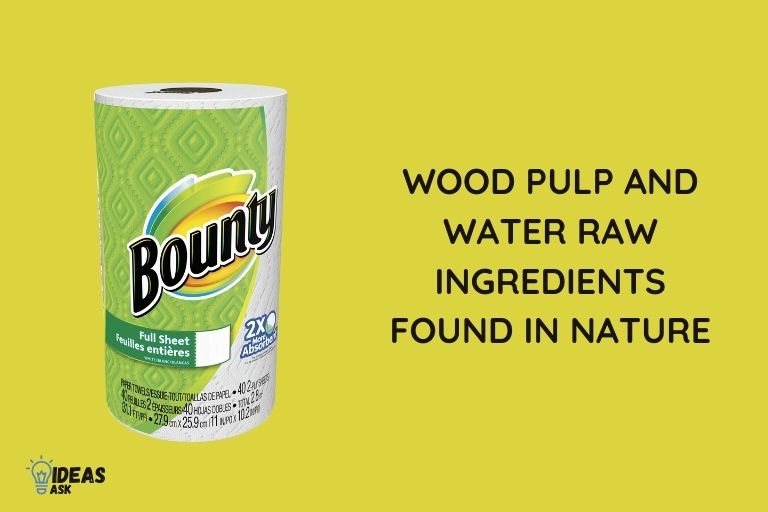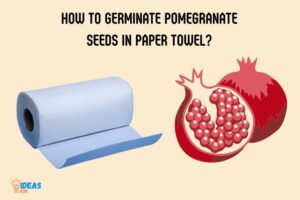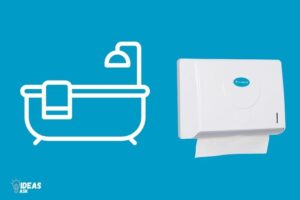What are Bounty Paper Towels Made of? Virgin Wood Pulp
Bounty paper towels are made from virgin wood pulp sourced from responsibly managed forests, which are then combined with water, chemicals, and adhesives to create a strong, absorbent, and durable paper product.
Virgin wood pulp is the primary material used in the production of Bounty paper towels. The wood pulp is derived from trees, specifically softwood and hardwood species, grown in sustainably managed forests.
The pulp is combined with water, chemicals, and adhesives, which help to break down the fibers in the wood pulp and bond them together.
This process results in a highly absorbent and strong paper product, designed for effective cleaning and wiping purposes.
Bounty paper towels are designed to provide superior cleaning performance, thanks to their strong, absorbent, and durable construction.
The use of virgin wood pulp sourced from responsibly managed forests ensures a high-quality and environmentally friendly product, which can effectively handle various cleaning and wiping tasks.
Additionally, Bounty continuously strives to improve its manufacturing processes in order to reduce waste and minimize its environmental footprint.
6 Material in Making Bounty Paper Towels :
| Material | Description | Usage in Bounty Paper Towels |
|---|---|---|
| Virgin Pulp | A type of paper pulp made from raw tree fibers. | Bounty paper towels are made from a mixture of virgin pulp sourced from responsibly managed forests. |
| Softwood fibers | Fibers extracted from softwood trees like pine, spruce, or fir. | Softwood fibers are long and provide strength, absorbency, and durability to Bounty paper towels. |
| Hardwood fibers | Fibers extracted from hardwood trees like oak, maple, or birch. | Hardwood fibers are short and contribute to the softness and smoothness of the paper towels. |
| Water | H2O, used in the papermaking process. | Water is mixed with fibers to create a pulp slurry that gets filtered and dried to form paper towels. |
| Chemical additives | Various chemicals used for different purposes in papermaking. | Additives could include dispersants, wet-strength agents, or softeners, which help improve the qualities of the final paper towel product. |
| Bleach | A chemical compound used to whiten and sanitize paper products. | Bounty paper towels are whitened using elemental chlorine-free (ECF) bleaching processes. |
Key Takeaway

Five Facts About Bounty Paper Towels
The Raw Materials Used In Bounty Paper Towels
Overview Of Raw Materials Necessary For Paper Towel Making
When it comes to paper towel production, there are a few raw materials that are necessary.
These materials include wood pulp, water, and chemicals. Here is a brief overview of each material:
- Wood pulp: This is the primary raw material used in paper towel production. It is derived from trees and is used to make the paper fibers that form the basis of the towel.
- Water: Water is used to hydrate the wood pulp and create a slurry that can be shaped into paper.
- Chemicals: Various chemicals are used in the paper-making process to break down the wood fibers and aid in the shaping and drying of the paper.
Detailed Discussion Of The Key Materials Used In Bounty Paper Towels
Bounty paper towels are known for their high absorbency and strength.
To achieve these qualities, a few key materials are used in their production.
- Tree pulp: Bounty paper towels are made from virgin pulp, which means that the wood fibers used to make the towels have not been previously used in any other paper products. This results in a stronger towel with higher absorbency.
- Water: As mentioned earlier, water is a necessary ingredient in paper-making. In the case of bounty paper towels, the water used is filtered and purified to ensure that it is free from any impurities that could impact the quality of the towel.
- Chemicals: Bounty paper towel production utilizes a mix of chemicals, including bleach, to help break down the wood fibers and shape the paper. The towels are also treated with a compound called silicone, which helps to increase their strength and resistance to tearing.
Description Of How Each Material Is Sourced And Processed
Now that we have an overview of the materials used in bounty paper towels, let’s take a closer look at how each material is sourced and processed.
- Tree pulp: Bounty sources its virgin pulp from sustainably managed forests in the united states and canada. The trees are harvested in a way that promotes regrowth and sustainability, ensuring that the forests remain healthy for years to come.
- Water: The water used in bounty paper towel production is sourced from a nearby river and then undergoes a rigorous purification process before it is suitable for use in paper-making.
- Chemicals: The chemicals used in bounty paper towel production are carefully selected and sourced from reputable suppliers. Once the chemicals are added to the wood pulp and water mixture, the slurry is shaped into paper using a machine called a fourdrinier.
The raw materials used in bounty paper towels are carefully selected and sourced to ensure that the towels are strong, absorbent, and able to tackle tough cleaning tasks.
By using sustainably sourced tree pulp, purified water, and high-quality chemicals, bounty is able to produce a towel that is tough on messes but gentle on the environment.
The Manufacturing Process Of Bounty Paper Towels
Bounty paper towels are a household staple for many, with their ability to clean up even the toughest messes in one swipe. But have you ever wondered what makes these paper towels unique?
In this blog post, we’ll dive into the manufacturing process of bounty paper towels and explore how they stand out from the rest.
Overview Of The Steps Involved In Making Paper Towels
Paper towels are made using a process similar to that of making any other type of paper.
Here are the basic steps involved:
- Wood chips are ground up into a pulp
- The pulp is mixed with water to form a slurry
- The slurry is spread out onto a screen and pressed to remove excess water
- The resulting paper is rolled, dried, and cut into rolls of paper towels
Explanation Of How Bounty Paper Towels Are Unique In Their Manufacturing Process
While the basic process used to create paper towels is the same across different brands, bounty paper towels have a unique manufacturing process that sets them apart.
Here are some key ways in which bounty paper towels stand out:
- Bounty paper towels are made using a blend of softwood and hardwood fibers, giving them a unique combination of strength and absorbency
- The paper used in the towels is also treated with a special resin, which helps to create a stronger, more durable product
- Bounty paper towels are compressed during the manufacturing process, which allows them to hold more liquid than other paper towels
Detailed Insight Into The Use Of Technology In Bounty Paper Towel Manufacturing
In addition to the unique materials and manufacturing process used to create bounty paper towels, technology also plays a significant role.
Here are some ways in which technology is used in the production of these towels:
- High-speed cameras are used to inspect the towels as they’re being made, ensuring that they meet quality standards
- Sensors are used to control the amount of resin that’s added to the paper, ensuring a consistent, high-quality product
- The manufacturing process itself is highly automated, with robots and other machines handling many of the steps involved
Bounty paper towels are a unique product that stand out from other paper towel brands. Their blend of softwood and hardwood fibers, special resin treatment, and use of technology during manufacturing all contribute to the high-quality, absorbent product that consumers know and love.
Environmental Impact Of Bounty Paper Towels
Discussion Of The Impact Of Paper Towel Production On The Environment
Paper towel production and usage have a significant impact on the environment.
Here are some of the key points:
- Deforestation: The production of paper towels requires a lot of trees. According to the natural resources defense council (nrdc), we lose at least 27,000 trees per day to toilet paper, tissues, and paper towels.
- Water usage: Massive amounts of water are used to process trees into paper, and then to manufacture paper towels. The nrdc reports that producing a single roll of paper towel consumes 544 gallons of water.
- Pollution: The bleaching and dyeing process produces pollution and chemical waste. The use of paper towels also contributes to landfill waste and ocean pollution.
Explanation Of The Measures Taken By Bounty To Reduce Their Environmental Impact
Bounty has taken several measures to reduce their environmental impact during production.
Here are some of the key points:
- Sustainable forestry: Bounty’s parent company, procter & gamble, has committed to using only sustainably-sourced pulp in their products by 2030. This means that their company will be forest-positive, meaning that they will grow more trees than they harvest.
- Water conservation: They have implemented water conservation measures in their manufacturing processes. Bounty’s paper mill in alabama has reduced water usage by 60%.
- Recycled fibers: Bounty has also introduced paper towels made from recycled materials, which uses less energy and water during the manufacturing process.
Comparison Of Bounty To Other Paper Towel Brands In Their Sustainability Efforts
Bounty has made significant strides in reducing their environmental impact, but how do they stack up against other paper towel brands?
Here are some key points:
- Seventh generation: This brand produces paper towels made entirely from recycled material and offers plant-based options for their cleaning products.
- Brawny: A subsidiary of georgia-pacific, brawny has committed to reducing waste during production by using materials more efficiently and producing less waste in their manufacturing process.
- Viva: This brand has introduced reusable paper towel alternatives, such as dishcloths and microfiber towels, to reduce the need for single-use paper towels.
While paper towel production has a negative impact on the environment, bounty and other brands are taking steps to reduce their environmental impact.
As consumers, we can take our own steps to reduce our usage of paper towels, such as using cloth towels or air drying hands. Small changes can make a big difference in preserving our planet.
FAQ On Bounty Paper Towels
What Are Bounty Paper Towels Made Of?
Bounty paper towels are made of virgin pulp and water. They do not contain any recycled material.
Are Bounty Paper Towels Environmentally Friendly?
No, bounty paper towels are not environmentally friendly. They are made of virgin pulp and do not contain recycled material.
Are Bounty Paper Towels Durable?
Yes, bounty paper towels are durable. They are designed to be strong and absorbent to clean up even the toughest messes.
Can Bounty Paper Towels Be Used For Cleaning Electronics?
Yes, bounty paper towels can be used to clean electronics. They are gentle enough not to scratch surfaces or leave residue.
Conclusion
To sum up, bounty paper towels are made of high-quality materials which make them incredibly absorbent and strong. The unique design makes cleaning up even the toughest messes a breeze. From cleaning up spills to polishing mirrors, bounty paper towels are versatile and reliable.
Made from sustainable materials, they are an environmentally friendly paper towel option. With their ability to hold up against wet or dry messes, bounty paper towels provide a great solution for busy households and businesses alike.
So if you’re looking for a paper towel that can handle anything from everyday spills to big messes, bounty paper towels are an excellent choice. With their strength and durability, you won’t be disappointed with their performance. Try them out for yourself and see the difference.





